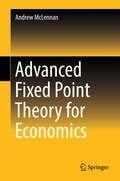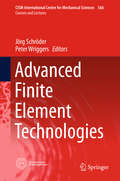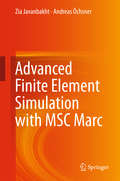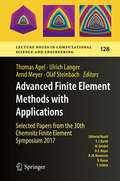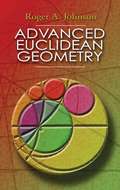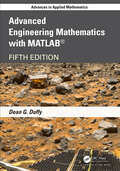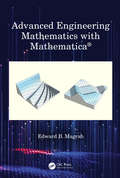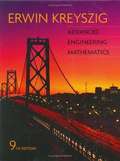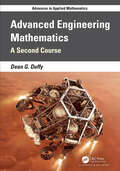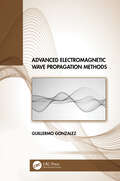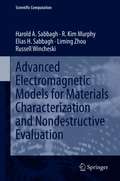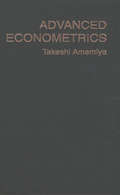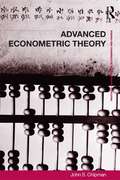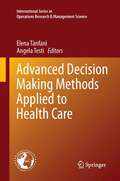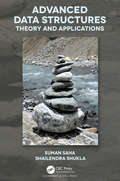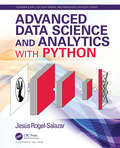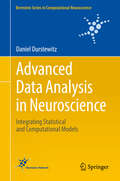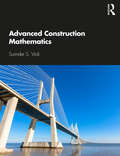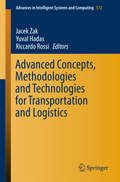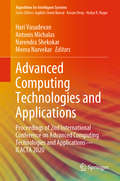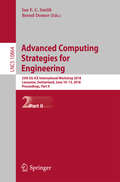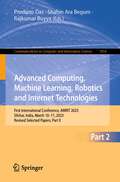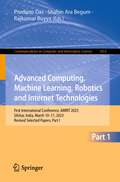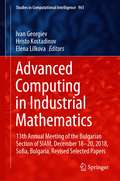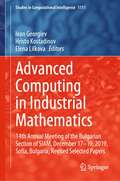- Table View
- List View
Advanced Fixed Point Theory for Economics
by Andrew McLennanThis book develops the central aspect of fixed point theory – the topological fixed point index – to maximal generality, emphasizing correspondences and other aspects of the theory that are of special interest to economics. Numerous topological consequences are presented, along with important implications for dynamical systems.The book assumes the reader has no mathematical knowledge beyond that which is familiar to all theoretical economists. In addition to making the material available to a broad audience, avoiding algebraic topology results in more geometric and intuitive proofs.Graduate students and researchers in economics, and related fields in mathematics and computer science, will benefit from this book, both as a useful reference and as a well-written rigorous exposition of foundational mathematics. Numerous problems sketch key results from a wide variety of topics in theoretical economics, making the book an outstanding text for advanced graduate courses in economics and related disciplines.
Advanced Finite Element Technologies (CISM International Centre for Mechanical Sciences #566)
by Peter Wriggers Jörg SchröderThe book presents an overview of the state of research of advanced finite element technologies. Besides the mathematical analysis, the finite element development and their engineering applications are shown to the reader. The authors give a survey of the methods and technologies concerning efficiency, robustness and performance aspects. The book covers the topics of mathematical foundations for variational approaches and the mathematical understanding of the analytical requirements of modern finite element methods. Special attention is paid to finite deformations, adaptive strategies, incompressible, isotropic or anisotropic material behavior and the mathematical and numerical treatment of the well-known locking phenomenon. Beyond that new results for the introduced approaches are presented especially for challenging nonlinear problems.
Advanced Finite Element Simulation with MSC Marc: Application of User Subroutines
by Andreas Öchsner Zia JavanbakhtThis book offers an in-depth insight into the general-purpose finite element program MSC Marc, which is distributed by MSC Software Corporation. It is a specialized program for nonlinear problems (implicit solver) which is common in academia and industry. The primary goal of this book is to provide a comprehensive introduction to a special feature of this software: the user can write user-subroutines in the programming language Fortran, which is the language of all classical finite element packages. This subroutine feature allows the user to replace certain modules of the core code and to implement new features such as constitutive laws or new elements. Thus, the functionality of commercial codes ('black box') can easily be extended by linking user written code to the main core of the program. This feature allows to take advantage of a commercial software package with the flexibility of a 'semi-open' code.
Advanced Finite Element Methods with Applications: Selected Papers from the 30th Chemnitz Finite Element Symposium 2017 (Lecture Notes in Computational Science and Engineering #128)
by Ulrich Langer Thomas Apel Arnd Meyer Olaf SteinbachFinite element methods are the most popular methods for solving partial differential equations numerically, and despite having a history of more than 50 years, there is still active research on their analysis, application and extension. This book features overview papers and original research articles from participants of the 30th Chemnitz Finite Element Symposium, which itself has a 40-year history. Covering topics including numerical methods for equations with fractional partial derivatives; isogeometric analysis and other novel discretization methods, like space-time finite elements and boundary elements; analysis of a posteriori error estimates and adaptive methods; enhancement of efficient solvers of the resulting systems of equations, discretization methods for partial differential equations on surfaces; and methods adapted to applications in solid and fluid mechanics, it offers readers insights into the latest results.
Advanced Euclidean Geometry
by Roger A. JohnsonFor many years, this elementary treatise on advanced Euclidean geometry has been the standard textbook in this area of classical mathematics; no other book has covered the subject quite as well. It explores the geometry of the triangle and the circle, concentrating on extensions of Euclidean theory, and examining in detail many relatively recent theorems. Several hundred theorems and corollaries are formulated and proved completely; numerous others remain unproved, to be used by students as exercises.The author makes liberal use of circular inversion, the theory of pole and polar, and many other modern and powerful geometrical tools throughout the book. In particular, the method of "directed angles" offers not only a powerful method of proof but also furnishes the shortest and most elegant form of statement for several common theorems. This accessible text requires no more extensive preparation than high school geometry and trigonometry.
Advanced Engineering Mathematics with MATLAB (Advances in Applied Mathematics)
by Dean G. DuffyIn the four previous editions the author presented a text firmly grounded in the mathematics that engineers and scientists must understand and know how to use. Tapping into decades of teaching at the US Navy Academy and the US Military Academy and serving for twenty-five years at (NASA) Goddard Space Flight, he combines a teaching and practical experience that is rare among authors of advanced engineering mathematics books. This edition offers a smaller, easier to read, and useful version of this classic textbook. While competing textbooks continue to grow, the book presents a slimmer, more concise option. Instructors and students alike are rejecting the encyclopedic tome with its higher and higher price aimed at undergraduates. To assist in the choice of topics included in this new edition, the author reviewed the syllabi of various engineering mathematics courses that are taught at a wide variety of schools. Due to time constraints an instructor can select perhaps three to four topics from the book, the most likely being ordinary differential equations, Laplace transforms, Fourier series and separation of variables to solve the wave, heat, or Laplace's equation. Laplace transforms are occasionally replaced by linear algebra or vector calculus. Sturm-Liouville problem and special functions (Legendre and Bessel functions) are included for completeness. Topics such as z-transforms and complex variables are now offered in a companion book, Advanced Engineering Mathematics: A Second Course by the same author. MATLAB is still employed to reinforce the concepts that are taught. Of course, this Edition continues to offer a wealth of examples and applications from the scientific and engineering literature, a highlight of previous editions. Worked solutions are given in the back of the book.
Advanced Engineering Mathematics with Mathematica
by Edward B. MagrabAdvanced Engineering Mathematics with Mathematica® presents advanced analytical solution methods that are used to solve boundary-value problems in engineering and integrates these methods with Mathematica® procedures. It emphasizes the Sturm–Liouville system and the generation and application of orthogonal functions, which are used by the separation of variables method to solve partial differential equations. It introduces the relevant aspects of complex variables, matrices and determinants, Fourier series and transforms, solution techniques for ordinary differential equations, the Laplace transform, and procedures to make ordinary and partial differential equations used in engineering non-dimensional. To show the diverse applications of the material, numerous and widely varied solved boundary value problems are presented.
Advanced Engineering Mathematics, 9th Edition
by Erwin KreyszigThis new edition continues the tradition of providing instructors and students with a comprehensive and up-to-date resource for teaching and learning engineering mathematics, that is, applied mathematics for engineers and physicists, mathematicians and computer scientists, as well as members of other disciplines. A course in elementary calculus is the sole prerequisite.
Advanced Engineering Mathematics: A Second Course with MatLab (Advances in Applied Mathematics)
by Dean G. DuffyThrough four previous editions of Advanced Engineering Mathematics with MATLAB, the author presented a wide variety of topics needed by today's engineers. The fifth edition of that book, available now, has been broken into two parts: topics currently needed in mathematics courses and a new stand-alone volume presenting topics not often included in these courses and consequently unknown to engineering students and many professionals. The overall structure of this new book consists of two parts: transform methods and random processes. Built upon a foundation of applied complex variables, the first part covers advanced transform methods, as well as z-transforms and Hilbert transforms--transforms of particular interest to systems, communication, and electrical engineers. This portion concludes with Green's function, a powerful method of analyzing systems. The second portion presents random processes--processes that more accurately model physical and biological engineering. Of particular interest is the inclusion of stochastic calculus. The author continues to offer a wealth of examples and applications from the scientific and engineering literature, a highlight of his previous books. As before, theory is presented first, then examples, and then drill problems. Answers are given in the back of the book. This book is all about the future: The purpose of this book is not only to educate the present generation of engineers but also the next. "The main strength is the text is written from an engineering perspective. The majority of my students are engineers. The physical examples are related to problems of interest to the engineering students." --Lea Jenkins, Clemson University
Advanced Electromagnetic Wave Propagation Methods
by Guillermo GonzalezThis textbook provides a solid foundation into many approaches that are used in the analysis of advanced electromagnetic wave propagation problems. The techniques discussed are essential to obtain closed-form solutions or asymptotic solutions and meet an existing need for instructors and students in electromagnetic theory. The book covers various advanced mathematical methods used in the evaluation of the electromagnetic fields in rectangular, cylindrical and spherical geometries. The mathematics of special functions (i.e., Bessel, Hankel, Airy, Legendre, Error, etc.) are covered in depth, including appropriate Appendices. The author takes particular care to provide detailed explanations of auxiliary potentials, Hertz’s vectors, Debye potentials, as well as the use of Green functions, the Watson transformation and the method of steepest descent in the solution of electromagnetic problems. Overall, Advanced Electromagnetic Wave Propagation Methods is a good source for the many skills required in obtaining closed form and asymptotic solution, which in many instances cannot be obtained using computer codes of Maxwell’s equations. Thus, it provides an excellent training for preparing graduate students in their research work. This book is intended for a graduate course in electromagnetic theory for students in electrical engineering. Students in physics and professionals will also find it appropriate and useful. Provides a comprehensive and unified treatment of radiation and propagation problems Presents a detailed explanation in the use of Green functions, the Watson transformation and the method of steepest descent as they apply to electromagnetic problems Demonstrates various advanced mathematical techniques used in the evaluation of the electromagnetic fields Details how to formulate and obtain a closed-form solution or an asymptotic solution Includes appendices for Bessel, Legendre, Airy and Error functions
Advanced Electromagnetic Models for Materials Characterization and Nondestructive Evaluation (Scientific Computation)
by Harold A Sabbagh R. Kim Murphy Elias H. Sabbagh Liming Zhou Russell WincheskiThis book expands on the subject matter of ’Computational Electromagnetics and Model-Based Inversion: A Modern Paradigm for Eddy-Current Nondestructive Evaluation.’ It includes (a) voxel-based inversion methods, which are generalizations of model-based algorithms; (b) a complete electromagnetic model of advanced composites (and other novel exotic materials), stressing the highly anisotropic nature of these materials, as well as giving a number of applications to nondestructive evaluation; and (c) an up-to-date discussion of stochastic integral equations and propagation-of-uncertainty models in nondestructive evaluation. As such, the book combines research started twenty-five years ago in advanced composites and voxel-based algorithms, but published in scattered journal articles, as well as recent research in stochastic integral equations. All of these areas are of considerable interest to the aerospace, nuclear power, civil infrastructure, materials characterization and biomedical industries. The book covers the topic of computational electromagnetics in eddy-current nondestructive evaluation (NDE) by emphasizing three distinct topics: (a) fundamental mathematical principles of volume-integral equations as a subset of computational electromagnetics, (b) mathematical algorithms applied to signal-processing and inverse scattering problems, and (c) applications of these two topics to problems in which real and model data are used. It is therefore more than an academic exercise and is valuable to users of eddy-current NDE technology in industries as varied as nuclear power, aerospace, materials characterization and biomedical imaging.
Advanced Econometrics
by Takeshi AmemiyaAdvanced Econometrics is both a comprehensive text for graduate students and a reference work for econometricians. It will also be valuable to those doing statistical analysis in the other social sciences. Its main features are a thorough treatment of cross-section models, including qualitative response models, censored and truncated regression models, and Markov and duration models, as well as a rigorous presentation of large sample theory, classical least-squares and generalized least-squares theory, and nonlinear simultaneous equation models. <P><P> Although the treatment is mathematically rigorous, the author has employed the theorem-proof method with simple, intuitively accessible assumptions. This enables readers to understand the basic structure of each theorem and to generalize it for themselves depending on their needs and abilities. Many simple applications of theorems are given either in the form of examples in the text or as exercises at the end of each chapter in order to demonstrate their essential points.
Advanced Econometric Theory (Routledge Advanced Texts in Economics and Finance)
by John ChipmanWhen learning econometrics, what better way than to be taught by one of its masters. In this significant new volume, John Chipman, the eminence grise of econometrics, presents his classic lectures in econometric theory. Starting with the linear regression model, least squares, Gauss-Markov theory and the first principals of econometrics, this book guides the introductory student to an advanced stage of ability. The text covers multicollinearity and reduced-rank estimation, the treatment of linear restrictions and minimax estimation. Also included are chapters on the autocorrelation of residuals and simultaneous-equation estimation. By the end of the text, students will have a solid grounding in econometrics. Despite the frequent complexity of the subject matter, Chipman's clear explanations, concise prose and sharp analysis make this book stand out from others in the field. With mathematical rigor sharpened by a lifetime of econometric analysis, this significant volume is sure to become a seminal and indispensable text in this area.
Advanced Decision Making Methods Applied to Health Care (International Series in Operations Research & Management Science #173)
by Angela Testi Elena TanfaniThe most difficult part of making decisions in the health care field on all levels (national, regional, institutional, patient) is linked to the very complexity of the system itself, to the intrinsic uncertainty involved and its dynamic nature. This requires not only the ability to analyze and interpret a large amount of information but also arrange it so that it becomes a cognitive base for appropriate decision-making. Moreover, decisions in the health care field are subjected to many challenges and constraints: fast change and uncertain outcomes, aging population, increasing citizen expectations, equity considerations and limited resources. Operations research, statistical and economic-related quantitative methods supply these decisions making tools and methodology. The contributed book presents a collection of applications to concrete situations detailing the problem area, the methodology employed, the implementation and results. Each topic addressed in the book will be structured in such a way that an interdisciplinary and wide audience will be able to use the materials presented. As an example the book chapters will address health policies issues, planning health services, epidemiology and disease modelling, home-care modelling, logistics in health care, capacity planning, quality and appropriateness.
Advanced Data Structures: Theory and Applications
by Suman Saha Shailendra ShuklaAdvanced data structures is a core course in Computer Science which most graduate program in Computer Science, Computer Science and Engineering, and other allied engineering disciplines, offer during the first year or first semester of the curriculum. The objective of this course is to enable students to have the much-needed foundation for advanced technical skill, leading to better problem-solving in their respective disciplines. Although the course is running in almost all the technical universities for decades, major changes in the syllabus have been observed due to the recent paradigm shift of computation which is more focused on huge data and internet-based technologies. Majority of the institute has been redefined their course content of advanced data structure to fit the current need and course material heavily relies on research papers because of nonavailability of the redefined text book advanced data structure. To the best of our knowledge well-known textbook on advanced data structure provides only partial coverage of the syllabus. The book offers comprehensive coverage of the most essential topics, including: Part I details advancements on basic data structures, viz., cuckoo hashing, skip list, tango tree and Fibonacci heaps and index files. Part II details data structures of different evolving data domains like special data structures, temporal data structures, external memory data structures, distributed and streaming data structures. Part III elucidates the applications of these data structures on different areas of computer science viz, network, www, DBMS, cryptography, graphics to name a few. The concepts and techniques behind each data structure and their applications have been explained. Every chapter includes a variety of Illustrative Problems pertaining to the data structure(s) detailed, a summary of the technical content of the chapter and a list of Review Questions, to reinforce the comprehension of the concepts. The book could be used both as an introductory or an advanced-level textbook for the advanced undergraduate, graduate and research programmes which offer advanced data structures as a core or an elective course. While the book is primarily meant to serve as a course material for use in the classroom, it could be used as a starting point for the beginner researcher of a specific domain.
Advanced Data Science and Analytics with Python (Chapman & Hall/CRC Data Mining and Knowledge Discovery Series)
by Jesus Rogel-SalazarAdvanced Data Science and Analytics with Python enables data scientists to continue developing their skills and apply them in business as well as academic settings. The subjects discussed in this book are complementary and a follow-up to the topics discussed in Data Science and Analytics with Python. The aim is to cover important advanced areas in data science using tools developed in Python such as SciKit-learn, Pandas, Numpy, Beautiful Soup, NLTK, NetworkX and others. The model development is supported by the use of frameworks such as Keras, TensorFlow and Core ML, as well as Swift for the development of iOS and MacOS applications. Features: Targets readers with a background in programming, who are interested in the tools used in data analytics and data science Uses Python throughout Presents tools, alongside solved examples, with steps that the reader can easily reproduce and adapt to their needs Focuses on the practical use of the tools rather than on lengthy explanations Provides the reader with the opportunity to use the book whenever needed rather than following a sequential path The book can be read independently from the previous volume and each of the chapters in this volume is sufficiently independent from the others, providing flexibility for the reader. Each of the topics addressed in the book tackles the data science workflow from a practical perspective, concentrating on the process and results obtained. The implementation and deployment of trained models are central to the book. Time series analysis, natural language processing, topic modelling, social network analysis, neural networks and deep learning are comprehensively covered. The book discusses the need to develop data products and addresses the subject of bringing models to their intended audiences – in this case, literally to the users’ fingertips in the form of an iPhone app. About the Author Dr. Jesús Rogel-Salazar is a lead data scientist in the field, working for companies such as Tympa Health Technologies, Barclays, AKQA, IBM Data Science Studio and Dow Jones. He is a visiting researcher at the Department of Physics at Imperial College London, UK and a member of the School of Physics, Astronomy and Mathematics at the University of Hertfordshire, UK.
Advanced Data Analysis in Neuroscience: Integrating Statistical and Computational Models (Bernstein Series in Computational Neuroscience)
by Daniel DurstewitzThis book is intended for use in advanced graduate courses in statistics / machine learning, as well as for all experimental neuroscientists seeking to understand statistical methods at a deeper level, and theoretical neuroscientists with a limited background in statistics. It reviews almost all areas of applied statistics, from basic statistical estimation and test theory, linear and nonlinear approaches for regression and classification, to model selection and methods for dimensionality reduction, density estimation and unsupervised clustering. Its focus, however, is linear and nonlinear time series analysis from a dynamical systems perspective, based on which it aims to convey an understanding also of the dynamical mechanisms that could have generated observed time series. Further, it integrates computational modeling of behavioral and neural dynamics with statistical estimation and hypothesis testing. This way computational models in neuroscience are not only explanat ory frameworks, but become powerful, quantitative data-analytical tools in themselves that enable researchers to look beyond the data surface and unravel underlying mechanisms. Interactive examples of most methods are provided through a package of MatLab routines, encouraging a playful approach to the subject, and providing readers with a better feel for the practical aspects of the methods covered. "Computational neuroscience is essential for integrating and providing a basis for understanding the myriads of remarkable laboratory data on nervous system functions. Daniel Durstewitz has excellently covered the breadth of computational neuroscience from statistical interpretations of data to biophysically based modeling of the neurobiological sources of those data. His presentation is clear, pedagogically sound, and readily useable by experts and beginners alike. It is a pleasure to recommend this very well crafted discussion to experimental neuroscientists as well as mathematically well versed Physicists. The book acts as a window to the issues, to the questions, and to the tools for finding the answers to interesting inquiries about brains and how they function. " Henry D. I. Abarbanel Physics and Scripps Institution of Oceanography, University of California, San Diego "This book delivers a clear and thorough introduction to sophisticated analysis approaches useful in computational neuroscience. The models described and the examples provided will help readers develop critical intuitions into what the methods reveal about data. The overall approach of the book reflects the extensive experience Prof. Durstewitz has developed as a leading practitioner of computational neuroscience. " Bruno B. Averbeck
Advanced Construction Mathematics
by Surinder VirdiAdvanced Construction Mathematics covers the range of topics that a student must learn in order to achieve success in Level 3 and 4 mathematics for the Pearson BTEC National and BTEC HNC/HND in Construction, Building Services, and Civil Engineering. Packed with easy to follow examples, its 18 chapters cover algebra (equations, transposition and evaluation of formulae), differentiation, integration, statistics and numerous other core concepts and their application in the construction/civil engineering field. The book explains technical processes before applying mathematical techniques to solve practical problems which gradually build in complexity. Each chapter contains self-test exercises and answers and numerous illustrations to simplify the essential maths required at Levels 3 and 4. The book is also a useful recap or primer for students on BSc or non-cognate MSc Construction and Civil Engineering degrees.
Advanced Concepts, Methodologies and Technologies for Transportation and Logistics (Advances in Intelligent Systems and Computing #572)
by Riccardo Rossi Jacek Żak Yuval HadasThis book is a collection of original papers produced by the members of the Euro Working Group on Transportation (EWGT) in the last several years (2015-2017). The respective chapters present the results of various research projects carried out by the members of the EWGT and extended versions of presentations given at the last several meetings of the EWGT. The book offers a representative sampling of the EWGT's research activities and covers the state-of-the-art in quantitative oriented transportation/logistics research. It highlights a range of advanced concepts, methodologies and technologies, divided into four major thematic streams: Multiple Criteria Analysis in Transportation and Logistics; Urban Transportation and City Logistics; Road Safety and Artificial Intelligence and Soft Computing in Transportation and Logistics. The book is intended for academics/researchers, analysts, business consultants, and graduate students who are interested in advanced techniques of mathematical modeling and computational procedures applied in transportation and logistics.
Advanced Computing Technologies and Applications: Proceedings of 2nd International Conference on Advanced Computing Technologies and Applications—ICACTA 2020 (Algorithms for Intelligent Systems)
by Hari Vasudevan Antonis Michalas Narendra Shekokar Meera NarvekarThis book features selected papers presented at the 2nd International Conference on Advanced Computing Technologies and Applications, held at SVKM’s Dwarkadas J. Sanghvi College of Engineering, Mumbai, India, from 28 to 29 February 2020. Covering recent advances in next-generation computing, the book focuses on recent developments in intelligent computing, such as linguistic computing, statistical computing, data computing and ambient applications.
Advanced Computing Strategies for Engineering: 25th EG-ICE International Workshop 2018, Lausanne, Switzerland, June 10-13, 2018, Proceedings, Part II (Lecture Notes in Computer Science #10864)
by Ian F. Smith Bernd DomerThis double volume set ( LNAI 10863-10864) constitutes the refereed proceedings of the 25th International Workshop, EG-ICE 2018, held in Lausanne, Switzerland, in June 2018. The 58 papers presented in this volume were carefully reviewed and selected from 108 submissions. The papers are organized in topical sections on Advanced Computing in Engineering, Computer Supported Construction Management, Life-Cycle Design Support, Monitoring and Control Algorithms in Engineering, and BIM and Engineering Ontologies.
Advanced Computing, Machine Learning, Robotics and Internet Technologies: First International Conference, AMRIT 2023, Silchar, India, March 10–11, 2023, Revised Selected Papers, Part II (Communications in Computer and Information Science #1954)
by Prodipto Das Shahin Ara Begum Rajkumar BuyyaThis two-volume set constitutes selected papers presented during the First International Conference on Advanced Computing, Machine Learning, Robotics and Internet Technologies, AMRIT 2023, held in Silchar, India, in March 2023.The 20 full papers and 27 short papers presented were thoroughly reviewed and selected from 110 submissions. They cover the following topics: artificial intelligence, machine learning, natural language processing, image processing, data science, soft computing techniques, computer networks and security, computer architecture and algorithms.
Advanced Computing, Machine Learning, Robotics and Internet Technologies: First International Conference, AMRIT 2023, Silchar, India, March 10–11, 2023, Revised Selected Papers, Part I (Communications in Computer and Information Science #1953)
by Prodipto Das Shahin Ara Begum Rajkumar BuyyaThis two-volume set constitutes selected papers presented during the First International Conference on Advanced Computing, Machine Learning, Robotics and Internet Technologies, AMRIT 2023, held in Silchar, India, in March 2023.The 20 full papers and 27 short papers presented were thoroughly reviewed and selected from 110 submissions. They cover the following topics: artificial intelligence, machine learning, natural language processing, image processing, data science, soft computing techniques, computer networks and security, computer architecture and algorithms.
Advanced Computing in Industrial Mathematics: 13th Annual Meeting of the Bulgarian Section of SIAM, December 18-20, 2018, Sofia, Bulgaria, Revised Selected Papers (Studies in Computational Intelligence #961)
by Ivan Georgiev Hristo Kostadinov Elena LilkovaThis book gathers the peer-reviewed proceedings of the 13th Annual Meeting of the Bulgarian Section of the Society for Industrial and Applied Mathematics, BGSIAM'18, held in Sofia, Bulgaria. The general theme of BGSIAM'18 was industrial and applied mathematics with particular focus on: mathematical physics, numerical analysis, high performance computing, optimization and control, mathematical biology, stochastic modeling, machine learning, digitization and imaging, advanced computing in environmental, biomedical and engineering applications.
Advanced Computing in Industrial Mathematics: 14th Annual Meeting of the Bulgarian Section of SIAM, December 17-19, 2019, Sofia, Bulgaria, Revised Selected Papers (Studies in Computational Intelligence #1111)
by Ivan Georgiev Hristo Kostadinov Elena LilkovaThis book gathers the peer-reviewed proceedings of the 14th Annual Meeting of the Bulgarian Section of the Society for Industrial and Applied Mathematics, BGSIAM'19, held in Sofia, Bulgaria. The general theme of BGSIAM'19 was industrial and applied mathematics with particular focus on mathematical physics, numerical analysis, high-performance computing, optimization and control, mathematical biology, stochastic modeling, machine learning, digitization and imaging, and advanced computing in environmental, biomedical, and engineering applications.
